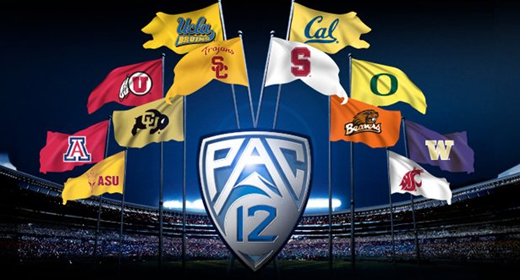With its men’s basketball tournament playing out this week in Las Vegas against a backdrop of ash and ruin, the Pac-12 leaves behind a parting gift — one final, fascinating irony for us to ponder.
The conference headed for collapse this summer was, in one essential regard, a decade ahead of its time.
All the issues currently crashing down on college sports, all the factors fueling a rapacious quest for cash, all the potholes that turned into a sinkhole — the Pac-12 presidents saw them coming.
They were clueless when it came to hiring the right commissioners and crafting a lasting media strategy but preposterously prescient about the legal and financial challenges that would eventually envelop the NCAA.
In the spring of 2014, the Pac-12 presidents approved a series of major reforms and took the package to their peers in the ACC, Big Ten, Big 12 and SEC for nationwide ratification.
The package included a reduction in the time demands placed on athletes — a problem that eventually became central to the National Labor Relations Board’s contention that athletes are employees.
The package featured a proposal to cover the full cost of attendance — an issue that would later surface in a lawsuit that went to the Supreme Court.
The Pac-12 presidents also pushed for a liberalized transfer policy and medical care for athletes beyond their eligibility clock.
Those topics and more were addressed in the proposal, and some were adopted later that year by the conference. But as the founding document of a new model designed to prevent a revolution, it went nowhere.
The presidents in the other major conferences rejected the reforms. Too radical. Unnecessary. A giant leap when baby steps were desired.
“The Pac-12 was trying to be proactive and should be applauded for that,” said Mike Aresco, commissioner of the American Athletic Conference.
Would they have changed the course of history? Might nationwide approval of the reforms have somehow saved the Pac-12 from collapse? Could they have staved off the barrage of lawsuits now threatening the NCAA model?
“The reforms would have been good,” Aresco added, “but would they have avoided the lawsuits? I’m not sure. I tend to doubt it.”
The proposal came during the start of the modern era of NCAA governance, when the five major conferences officially gained a degree of legislative independence — they became known as the Autonomy Five — from the rest of Division I.
The reform package was, effectively, a call to arms.
“We believe that bold rather than incremental action must be taken now,” the Pac-12 presidents wrote on May 22, 2014.
Without bold action, the resulting “loss of momentum at this crucial time could leave the field to more extreme viewpoints that seek either to do away with college athletics entirely or professionalize them to such an extent as to have the same result.”
The first proposal in the letter (published in full below) addressed the hottest issue of the time: The cost of attendance, defined as the true expense associated with attending college beyond the value of athletic scholarships that cover room, books and board.
The Pac-12 presidents wanted to create “scholarship awards up to the full cost of attendance.”
Eventually, the Supreme Court would agree, ruling in Alston v. NCAA that athletes were entitled to education-related benefits.
Yet the NCAA still faces a series of lawsuits dealing “with the rules that prohibit schools from directly paying athletes NIL (name, image and likeness) compensation and compensation for athletic performance,” Mit Winter, a prominent sports attorney for the firm Kennyhertz Perry, told the Hotline via email.
“Short of the Pac-12 persuading the NCAA/Autonomy Five presidents to eliminate those rules,” Winter added, “the lawsuits … were likely always going to be brought.”
But there were at least two reforms in the Pac-12 proposal that might have altered the trajectory of college sports had they been adopted a decade ago, according to Winter, Aresco and other industry experts who reviewed the reforms at the Hotline’s request but declined to comment.
— Time demands
The Pac-12 presidents hoped to “decrease the time demands placed on the student-athlete in-season, and correspondingly enlarge the time available for studies and full engagement in campus life, by doing the following:
“a. Prevent the abuse of organized ‘voluntary’ practices to circumvent the limit of 20 hours per week.
“b. More realistically assess the time away from campus and other commitments during the season, including travel time.”
Additionally, they pushed for decreasing time demands “out of season by reducing out-of-season competition and practices, and by considering shorter seasons in specific sports.”
How would that have changed the legal challenges currently facing the NCAA?
The push by the National Labor Relations Board to have college athletes become employees — examples include Dartmouth basketball players recently voting to unionize and a separate complaint filed against USC, the Pac-12 and the NCAA — is directly related to control. Many athletes at top-tier football and basketball schools are scheduled from 7 a.m. to 10 p.m.
“The amount of revenue being generated in college athletics in general right now is so great that the legal system was bound to be used to address the fact that athletes aren’t directly sharing in that revenue,” Winter wrote. “Having athletes declared employees is one way to make that happen.
“It is possible that schools and the NCAA would currently have a better argument that college athletes aren’t employees if the Pac-12 time demand proposal had been enacted, because they are aimed at reducing the amount of control exercised over the athletes.
“But even in that case, the amount of control exercised over the athletes would still likely be great enough for the NLRB or a court to find the athletes qualify as employees under the law.”
— Transfer policy
The last of the 10 reforms listed in the May 2014 letter calls for the major conferences to “liberalize the current rules limiting the ability of student-athletes to transfer between institutions.”
Specifically, the Pac-12 presidents were supportive of granting immediate eligibility to football and men’s basketball players who transferred schools while in good academic standing, according to a source with direct knowledge of the discussions.
But the other conferences declined, bottling up an issue that eventually exploded.
Under intense pressure to reform following COVID, the NCAA changed policy and allowed first-time transfers to be eligible immediately at their new schools.
And in December of 2023, a federal judge issued a temporary restraining order granting the same right to second-time transfers.
Winter called this issue “the one exception” within the Pac-12’s proposal: If the reforms had, in fact, “led to the NCAA eliminating its year-in-residence transfer rule for all transfers like we have now after the rule was enjoined by a federal court … that lawsuit wouldn’t have been brought.”
Would nationwide adoption of the Pac-12’s reform package a decade ago have saved the conference from implosion?
Winter is skeptical given that realignment is not about legislative matters but, rather, the “never-ending quest to increase athletics revenue.”
Aresco agreed.
“What destroyed the Pac-12 was the TV deal,” he said. “There were larger forces at work.”
But this much is clear and tragic for the conference: If the Pac-12 presidents had been as visionary with their media strategy as their legislative reforms, this men’s basketball tournament would not be the last.
“Other conferences were thinking about this stuff, but nobody actually proposed it,” Aresco said. “In that way, the Pac-12 was ahead of its time.”
May 22, 2014
Dear Colleagues:
We are writing to you, our colleagues at the member institutions of the Pac-12’s four peer conferences, because we believe that the events of the last few months have underscored the urgency with which we must move forward in reforming the rules that govern intercollegiate athletics, and because we believe that bold rather than incremental action must be taken now.
Due in no small part to the support you and your conferences have provided, the NCAA Governance Steering Committee and the NCAA Board have made great progress toward supporting the autonomy our five conferences have been seeking to implement important reforms. Nevertheless, we remain concerned that the process remains vulnerable to inertia or attempts to override, disagreement over details, and incrementalism, all of which may contribute to harmful delay. Because it is essential that the issue of autonomy, and the specific reforms we intend to enact once given that autonomy, be clear coming out of the NCAA meeting in August, we believe this is a crucial time – as we all head into our respective Board meetings in the coming weeks – to ensure that we are all advocating for substantial and meaningful change.
We need not have every last detail worked out. Our conference and campus experts can work on those details in the coming months, but we as CEOs must set and announce the substance of our reform agenda as soon as possible. It is clear from the recent statements of any number of individuals that, while they may share our view that labor unions are not the answer, the time has come for a meaningful response both to the student-athletes’ grievances and to the need to reassert the academic primacy of our mission.
We are confident that you share our sense of urgency. A loss of momentum at this crucial time could leave the field to more extreme viewpoints that seek either to do away with college athletics entirely or professionalize them to such an extent as to have the same result. Thousands of student-athletes in those sports – the vast majority of whom will go on to careers outside of their sport – could lose their access to a system that has supported the
education of generations of students, and strengthened bonds among students, alumni, and
our communities.
For these reasons, we have outlined below our principal objectives for reform, addressing both the need to increase the funding for student-athlete driven initiatives and the restoration of academic primacy to the mission of intercollegiate athletics:
1. Permit institutions to make scholarship awards up to the full cost of attendance.
2. Provide reasonable on-going medical or insurance assistance for student-athletes who suffer an incapacitating injury in competition or practice. Continue efforts to reduce the incidence of disabling injury.
3. Guarantee scholarships for enough time to complete a bachelor’s degree, provided that the student remains in good academic standing.
4. Decrease the time demands placed on the student-athlete in-season, and correspondingly enlarge the time available for studies and full engagement in campus life, by doing the following:
a. Prevent the abuse of organized “voluntary” practices to circumvent the limit of 20 hours per week.
b. More realistically assess the time away from campus and other commitments during the season, including travel time.
5. Similarly decrease time demands out of season by reducing out-of-season competition and practices, and by considering shorter seasons in specific sports.
6. Further strengthen the Academic Progress Rate requirements for post-season play.
7. Address the “one and done” phenomenon in men’s basketball. If the National Basketball Association and its Players Association are unable to agree on raising the age limit for players, consider restoring the freshman ineligibility rule in men’s basketball.
8. Provide student-athletes a meaningful role in governance at the conference and
NCAA levels.
9. Adjust existing restrictions so that student-athletes preparing for the next stage in their careers are not unnecessarily deprived of the advice and counsel of agents and other competent professionals, but without professionalizing intercollegiate athletics.
10. Liberalize the current rules limiting the ability of student-athletes to transfer between institutions.
While each of our conferences likely has additional items on its agenda, we believe these are the core objectives toward which we all are striving. We acknowledge this agenda could prove to be expensive and controversial, but the risks of inaction or moving too slowly are far greater. The time for tinkering with the rules and making small adjustments is over.
We are confident that you will join us in this final push to enact the NCAA reforms described above, and we would very much appreciate hearing from you so that we can accurately gauge the level of alignment among our five conferences and 65 institutions.
Please let us know your response on this reform agenda by June 4 by reply to this email message or through your conference commissioner. It is important to know where everyone is on these specifics before our colleagues meet together in Dallas on June 16.
With best wishes,
President Ann Weaver Hart, University of Arizona
President Michael Crow, Arizona State University
Chancellor Nicholas Dirks, University of California Berkeley
Chancellor Philip DiStefano, University of Colorado
President Michael Gottfredson, University of Oregon
President Edward Ray, Oregon State University
President John Hennessy, Stanford University
Chancellor Gene Block, UCLA
President C.L. Max NIkias, USC
President David Pershing, Utah
President Michael Young, University of Washington
President Elson S. Floyd, Washington State University
*** Send suggestions, comments and tips (confidentiality guaranteed) to pac12hotline@bayareanewsgroup.
*** Follow me on Twitter: @WilnerHotline
*** Pac-12 Hotline is not endorsed or sponsored by the Pac-12 Conference, and the views expressed herein do not necessarily reflect the views of the Conference.
xxx
Related posts:
 Wilner Hotline – Pac-12 Mailbag, Big Miss on Arizona Basketball, More
Wilner Hotline – Pac-12 Mailbag, Big Miss on Arizona Basketball, More 
(AP Photo/Ralph Freso, File)
Wilner – Pac-12 collapse: Tracing the 12 strategic blunders that led to Doomsday Hotline mailbag: Detailing the Pac-12’s liabilities, the ‘Pac-2’ and the MW, future of the NW rivalries, CFP rules, Bay Area regret and more
Hotline mailbag: Detailing the Pac-12’s liabilities, the ‘Pac-2’ and the MW, future of the NW rivalries, CFP rules, Bay Area regret and more  Wilner – Vision for the future of Pac-12 football: It’s 2033, and the conference has reformed with the old guard
Wilner – Vision for the future of Pac-12 football: It’s 2033, and the conference has reformed with the old guard
